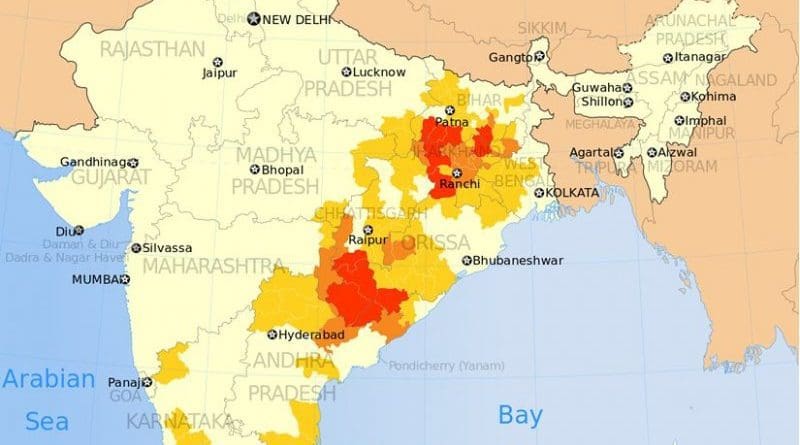Maoist Extremism: Changing Strategies? – Analysis
By Ashok Sahu
Maoist extremism in India took a new turn in 2004 with the merger of its two operational wings: one active in undivided Bihar and West Bengal called Maoist Communist Centers and the other known as Peoples War Group which was active in Dandkarnya area stretching from eastern Maharashtra to Malkangiri in Orrisa covering Chhattisgarh and Andhra Pradesh in between. Out of the merger was born the CPI (Maoist), sharing the leadership and the territorial control among the two components though both top two leaders Ganapathy and Kishanji hail from Andhra Pradesh. It coincided with the formation of the UPA government at the centre with leftist support in the same year. Prime Minister Manmohan Singh has also gone into records for having warned the nation that the Maoist menace is the greatest threat to the national integration since independence.
All along, his Home Minister Shivraj Patil had been down playing the threat that continued till his final eclipse from the central Cabinet, and he was replaced by P Chidambaram. By the time Chidambaram could succeed in formulating a workable solution within the federal framework, for the Maoist infested states, the UPA government had done away with the leftist support. Unlike the Congress government under the leadership of Indira Gandhi, the lack of political will to take concerned and firm action against the Maoist extremism appears to be directly linked with the presence of the leftist parties in policy making in the centre.
The Maoists at different times have been able to infiltrate into other political parties and have also been successful in having supporters and sympathizers in the ruling parties in the states by bargaining and benefiting them at times of elections. It is part of their strategy that they have been using to protract their struggle and their ideological movement in India till the final stage is struck to seize power at the centre. From 2004 till 2010, the Maoists taking full advantage of the political uncertainties compounded by opportunistic politics at the centre, have been successfully spreading their tentacles into new areas and have reached the second stage of their well calculated strategy of covering urban areas and the industrial belt.
This change in their strategy coincides with China discarding many of the old weaponry now in use by its soldiers in the Peoples’ Army and its coming to the Peoples Liberation Guerilla Army (PLGA) in India. To match it, the Maoists in India are going for a massive recruitment in the contiguous tribal belt covering Jharkhand, Chhattisgarh, West Bengal, Odisha and Andhra Pradesh, now identified as the Red Corridor covering more than 40,000 square kilometers.
In the name of emancipation of the poor and the illiterate, some of the churches financed by foreign funds are also helping in the fresh recruitment. Here the internal security of India and the external factors are directly linked to the destabilization process in our country. At some point or the other, all the adversaries of India will converge together for a common purpose and individual gains to the foreign players in internal matters, whether it is conversion to Christianity of the tribal chunk in the Indian population, regional leadership of India in South East Asia, or seizing the Centre through gun power and facilitating Maoist imperialism.
Now that there is a consensus to fight the Maoists before they inflict more damage to the nationalist cause, it must be seen how the corrective operation is put to use effectively and with minimal loss to human lives and national property. During the initial stage of the operation that started in Lalgarh area, the result was encouraging with full cooperation by the CPI (Marxist) government in West Bengal whose party cadres became individual targets of the Maoists, perhaps as a result of a tacit quid pro quo between the Maoists and Mamata Bannerji. But later, it got mired by the Maoists using the Mamata factor and politicizing the operation. In Chhatisgarh there is lack of unity in ‘command and control’ among the IPS officers in the field and the senior officials in the central paramilitary forces on deployment in the state. It is not a serious problem that cannot be controlled, but its persistence leads to serious consequences in public perception.
Though the IPS is an All India Service but the police are a state subject in the Constitution that has contributed in splitting allegiance by the officials to two sets of political leadership when different parties rule at the Centre and the State concerned. The post mortem of events following the Dantewada Maoist massacre reveals that there was serious lack of coordination at the police leadership in the field where the policy is being implemented. EN Rammohan’s report is very clear in pointing out these lacunae. Though there is no lack of political will and understanding between the Chhattisgarh Chief Minister and the Union Home Ministry, there are differences in holding the individual officers responsible for the serious lapses, and, punishing the delinquent. Without correctional measures through exemplary punishments, no system can be effective.

